| Listing 1 - 10 of 18 | << page >> |
Sort by
|
Book
ISBN: 9782100512492 2100512498 Year: 2007 Publisher: Paris : Dunod,
Abstract | Keywords | Export | Availability | Bookmark
 Loading...
Loading...Choose an application
- Reference Manager
- EndNote
- RefWorks (Direct export to RefWorks)
Musique --- Musique électroacoustique --- Psychoacoustique --- Son --- Traitement du signal --- Informatique --- Enregistrement et reproduction --- Techniques numériques --- Musique --- Musique électroacoustique --- Psychoacoustique --- Son --- Traitement du signal --- Informatique --- Enregistrement et reproduction --- Techniques numériques
Book
ISBN: 9782843650949 2843650941 Year: 2007 Publisher: Paris : ADBS,
Abstract | Keywords | Export | Availability | Bookmark
 Loading...
Loading...Choose an application
- Reference Manager
- EndNote
- RefWorks (Direct export to RefWorks)
Image processing --- Image databases --- Photographs --- Copyright --- Visual sociology --- Traitement d'images --- Banques d'images --- Photographies --- Droit d'auteur --- Sociologie visuelle --- Digital techniques --- Conservation and restoration --- Interactive multimedia --- Techniques numériques --- Conservation et restauration --- Multimédias interactifs --- Techniques numériques --- Multimédias interactifs
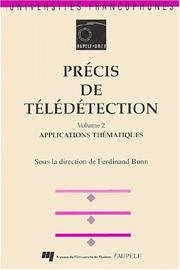
ISBN: 2760506134 2760508889 2760511456 9782760514850 9782760511453 9782760506138 2760514854 Year: 2007 Publisher: Québec : Presses de l'Université du Québec : Agence universitaire de la Francophonie,
Abstract | Keywords | Export | Availability | Bookmark
 Loading...
Loading...Choose an application
- Reference Manager
- EndNote
- RefWorks (Direct export to RefWorks)
Remote sensing. --- Environmental Sciences and Forestry. Remote Sensing and Geographical Information Systems --- Remote Sensing. --- Images de télédétection --- Remote-sensing images. --- Photo-interprétation --- Photographic interpretation --- Remote sensing --- methodology --- computer applications --- techniques --- Equipment --- Electromagnetic field --- Data analysis --- data collection --- Télédétection --- Remote-sensing images --- Traitement d'images --- Image processing --- Géographie (discipline) --- Information storage and retrieval systems --- Mathématiques --- Mathematics. --- Techniques numériques --- Digital techniques --- Systèmes d'information. --- Geography --- Images de télédétection. --- Mathématiques. --- Photo-interprétation. --- Techniques numériques. --- Images de télédétection. --- Images de télédétection --- Mathématiques. --- Rayonnement electromagnetique --- Photo-interprétation. --- Géographie (discipline) --- Techniques numériques. --- Systèmes d'information.
Book
ISBN: 9782296025899 Year: 2007 Publisher: Paris : Harmattan,
Abstract | Keywords | Export | Availability | Bookmark
 Loading...
Loading...Choose an application
- Reference Manager
- EndNote
- RefWorks (Direct export to RefWorks)
Motion pictures --- Cinéma --- Sound effects --- Congresses --- Son --- Congrès --- Cinema --- Congresses. --- Congres --- Cinéma --- Congrès --- Art multimédia --- Multimédias interactifs --- Sons --- Arts --- Traitement d'images --- Dans l'art --- Numérisation --- Techniques numériques --- Enregistrement et reproduction --- Art multimédia --- Multimédias interactifs --- Numérisation --- Techniques numériques
Book
ISBN: 9782100499793 9782100499809 Year: 2007 Publisher: Paris : Dunod,
Abstract | Keywords | Export | Availability | Bookmark
 Loading...
Loading...Choose an application
- Reference Manager
- EndNote
- RefWorks (Direct export to RefWorks)
Sound --- Image transmission --- Audio-visual equipment --- Audio-visual materials --- Multimedia systems --- Signal processing --- Son --- Transmission des images --- Audiovisuel --- Multimédia --- Traitement du signal --- Recording and reproducing --- Equipment and supplies --- Handbooks, manuals, etc. --- Digital techniques --- Enregistrement et reproduction --- Appareils et matériel --- Guides, manuels, etc. --- Techniques numériques --- Multimédia --- Appareils et matériel --- Techniques numériques
Periodical
ISSN: 17519659 17519667 Year: 2007 Publisher: Stevenage IET
Abstract | Keywords | Export | Availability | Bookmark
 Loading...
Loading...Choose an application
- Reference Manager
- EndNote
- RefWorks (Direct export to RefWorks)
Image processing --- Signal processing --- Traitement d'images --- Traitement du signal --- Digital techniques --- Periodicals --- Techniques numériques --- Périodiques --- Image processing. --- Engineering --- Civil Engineering --- Techniques numériques --- Périodiques --- EBSCOASP-E EBSCOBSP-E EJINGEN EPUB-ALPHA-I EPUB-PER-FT IET-E --- image processing --- image enhancement --- image analysis --- image coding and transmission --- multimedia --- Pictorial data processing --- Picture processing --- Processing, Image --- Imaging systems --- Optical data processing --- Signal processing. --- Information measurement --- Signal theory (Telecommunication) --- Processing, Signal --- Image processing - Periodicals --- Signal processing - Periodicals
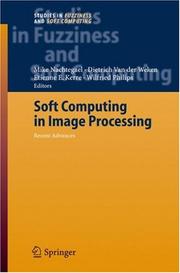
ISBN: 9783540382324 3540382321 9786610949281 1280949287 354038233X Year: 2007 Publisher: Berlin, Germany ; New York, New York : Springer,
Abstract | Keywords | Export | Availability | Bookmark
 Loading...
Loading...Choose an application
- Reference Manager
- EndNote
- RefWorks (Direct export to RefWorks)
Images have always been very important in human life. Their applications range from primitive communication between humans of all ages to advanced technologies in the industrial, medical and military field. The increased possibilities to capture and analyze images have contributed to the largeness that the scientific field of "image processing" has become today. Many techniques are being applied, including soft computing. "Soft Computing in Image Processing: Recent Advances" follows the edited volumes "Fuzzy Techniques in Image Processing" (volume 52, published in 2000) and "Fuzzy Filters for Image Processing" (volume 122, published in 2003), and covers a wide range of both practical and theoretical applications of soft computing in image processing. The 16 excellent chapters of the book have been grouped into five parts: Applications in Remote Sensing, Applications in Image Retrieval, Applications in Image Analysis, Other Applications, and Theoretical Contributions. The focus of the book is on practical applications, which makes it interesting for every researcher that is involved with soft computing, image processing, or both scientific branches.
Soft computing --- Image processing --- Informatique douce --- Traitement d'images --- Digital techniques --- Techniques numériques --- Electronic books. -- local. --- Fuzzy algorithms. --- Image processing -- Digital techniques. --- Civil Engineering --- Computer Science --- Applied Mathematics --- Civil & Environmental Engineering --- Engineering & Applied Sciences --- Soft computing. --- Digital techniques. --- Digital image processing --- Engineering. --- Artificial intelligence. --- Applied mathematics. --- Engineering mathematics. --- Appl.Mathematics/Computational Methods of Engineering. --- Artificial Intelligence (incl. Robotics). --- Algorithms --- Cluster set theory --- Fuzzy mathematics --- Digital electronics --- Mathematical and Computational Engineering. --- Artificial Intelligence. --- Engineering --- Engineering analysis --- Mathematical analysis --- AI (Artificial intelligence) --- Artificial thinking --- Electronic brains --- Intellectronics --- Intelligence, Artificial --- Intelligent machines --- Machine intelligence --- Thinking, Artificial --- Bionics --- Cognitive science --- Digital computer simulation --- Electronic data processing --- Logic machines --- Machine theory --- Self-organizing systems --- Simulation methods --- Fifth generation computers --- Neural computers --- Mathematics --- Cognitive computing --- Computational intelligence
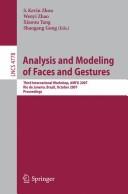
ISBN: 9783540756897 3540756892 3540756906 Year: 2007 Publisher: Berlin, Germany : Springer,
Abstract | Keywords | Export | Availability | Bookmark
 Loading...
Loading...Choose an application
- Reference Manager
- EndNote
- RefWorks (Direct export to RefWorks)
The 2007 IEEE International Workshop on Analysis and Modeling of Faces and Gestures(AMFG)isthethirdworkshopofitstypeorganizedinconjunctionwith ICCV, this time in Rio de Janeiro, Brazil. Our primary goal is to bring together researchersand research groupsto review the status of recognition, analysis and modeling of face, gesture, activity, and behavior; to discuss the challenges that we are facing; and to explore future directions. This year we received 55 submissions. Each paper was reviewed by three program committee members. The whole reviewing process was double blind. However,due to size limit, we were only able to accommodate 22 papers, among which 8 are orals and 14 are posters. The topics covered by these accepted papers include feature representation, 3D face, robust recognition under pose and illumination variations,video-basedface recognition,learning,facial motion analysis, body pose estimation, and sign recognition. A special word of thanks goes to Dr. Feng Zhao, our organizing chair, for his dedication and great e?orts in maintaining both the online submission system and workshop website and in handling most of the author contacts. We are indebted to the advisory committee members for their valuable suggestions and to the program committee members for their hard work and timely reviews. Finally, we thank Cognitec System GmbH and Siemens Corporate Research for their sponsorship. October 2007 S. Kevin Zhou Wen-Yi Zhao Xiaoou Tang Shaogang Gong Organization AMFG 2007 was held in conjunction with ICCV 2007. Workshop Chairs S. Kevin Zhou Siemens Corporate Research Wen-Yi Zhao Intuitive Surgical, Inc.
Optical pattern recognition --- Human face recognition (Computer science) --- Face perception --- Gesture --- Image processing --- Computer software --- Reconnaissance optique des formes (Informatique) --- Reconnaissance des visages (Informatique) --- Perception des visages --- Gestes --- Traitement d'images --- Logiciels --- Congresses. --- Computer simulation --- Digital techniques --- Human factors --- Congrès --- Simulation par ordinateur --- Techniques numériques --- Facteurs humains --- Congresses --- Computer Science --- Electrical Engineering --- Applied Physics --- Engineering & Applied Sciences --- Electrical & Computer Engineering --- Mudra --- Face recognition (Psychology) --- Facial perception --- Facial recognition (Psychology) --- Recognition, Facial (Psychology) --- Computer science. --- Algorithms. --- Artificial intelligence. --- Computer graphics. --- Image processing. --- Pattern recognition. --- Computer Science. --- Pattern Recognition. --- Image Processing and Computer Vision. --- Artificial Intelligence (incl. Robotics). --- Computer Graphics. --- Algorithm Analysis and Problem Complexity. --- Design perception --- Pattern recognition --- Form perception --- Perception --- Figure-ground perception --- Pictorial data processing --- Picture processing --- Processing, Image --- Imaging systems --- Optical data processing --- Automatic drafting --- Graphic data processing --- Graphics, Computer --- Computer art --- Graphic arts --- Electronic data processing --- Engineering graphics --- AI (Artificial intelligence) --- Artificial thinking --- Electronic brains --- Intellectronics --- Intelligence, Artificial --- Intelligent machines --- Machine intelligence --- Thinking, Artificial --- Bionics --- Cognitive science --- Digital computer simulation --- Logic machines --- Machine theory --- Self-organizing systems --- Simulation methods --- Fifth generation computers --- Neural computers --- Algorism --- Algebra --- Arithmetic --- Informatics --- Science --- Foundations --- Optical pattern recognition. --- Computer vision. --- Computer software. --- Artificial Intelligence. --- Software, Computer --- Computer systems --- Machine vision --- Vision, Computer --- Artificial intelligence --- Pattern recognition systems --- Pattern perception --- Perceptrons --- Visual discrimination --- Optical data processing. --- Optical computing --- Visual data processing --- Integrated optics --- Photonics --- Computers --- Optical equipment
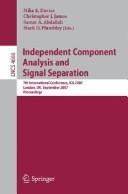
ISBN: 9783540744931 3540744932 3540744940 Year: 2007 Publisher: Berlin ; New York : Springer,
Abstract | Keywords | Export | Availability | Bookmark
 Loading...
Loading...Choose an application
- Reference Manager
- EndNote
- RefWorks (Direct export to RefWorks)
This volume contains the papers presented at the 7th International Conference on Independent Component Analysis (ICA) and Source Separation held in L- don, 9-12 September 2007, at Queen Mary, University of London. Independent Component Analysis and Signal Separation is one of the most exciting current areas of research in statistical signal processing and unsup- vised machine learning. The area has received attention from several research communities including machine learning, neural networks, statistical signal p- cessing and Bayesian modeling. Independent Component Analysis and Signal Separation has applications at the intersection of many science and engineering disciplinesconcernedwithunderstandingandextractingusefulinformationfrom data as diverse as neuronal activity and brain images, bioinformatics, com- nications, the World Wide Web, audio, video, sensor signals, or time series. This year's event was organized by the EPSRC-funded UK ICA Research Network (www.icarn.org). There was also a minor change to the conference title this year with the exclusion of the word'blind'. The motivation for this was the increasing number of interesting submissions using non-blind or semi-blind techniques that did not really warrant this label. Evidence of the continued interest in the held was demonstrated by the healthy number of submissions received, and of the 149 papers submitted just over two thirds were accepted.
Signal processing --- Blind source separation --- Neural networks (Computer science) --- Electronic noise --- Multivariate analysis --- Traitement du signal --- Réseaux neuronaux (Informatique) --- Bruit électronique --- Analyse multivariée --- Digital techniques --- Congresses. --- Techniques numériques --- Congrès --- Independent component analysis --- Telecommunications --- Computer Science --- Electrical & Computer Engineering --- Engineering & Applied Sciences --- Blind signal separation --- BSS (Blind source separation) --- Computer science. --- Coding theory. --- Computers. --- Algorithms. --- Data mining. --- Statistics. --- Computer Science. --- Algorithm Analysis and Problem Complexity. --- Computation by Abstract Devices. --- Coding and Information Theory. --- Statistics and Computing/Statistics Programs. --- Data Mining and Knowledge Discovery. --- Signal, Image and Speech Processing. --- Statistical analysis --- Statistical data --- Statistical methods --- Statistical science --- Mathematics --- Econometrics --- Algorithmic knowledge discovery --- Factual data analysis --- KDD (Information retrieval) --- Knowledge discovery in data --- Knowledge discovery in databases --- Mining, Data --- Database searching --- Algorism --- Algebra --- Arithmetic --- Automatic computers --- Automatic data processors --- Computer hardware --- Computing machines (Computers) --- Electronic brains --- Electronic calculating-machines --- Electronic computers --- Hardware, Computer --- Computer systems --- Cybernetics --- Machine theory --- Calculators --- Cyberspace --- Data compression (Telecommunication) --- Digital electronics --- Information theory --- Signal theory (Telecommunication) --- Computer programming --- Informatics --- Science --- Foundations --- Source separation (Signal processing) --- Computer software. --- Mathematical statistics. --- Statistical inference --- Statistics, Mathematical --- Statistics --- Probabilities --- Sampling (Statistics) --- Software, Computer --- Information theory. --- Statistics . --- Signal processing. --- Image processing. --- Speech processing systems. --- Computational linguistics --- Electronic systems --- Modulation theory --- Oral communication --- Speech --- Telecommunication --- Singing voice synthesizers --- Pictorial data processing --- Picture processing --- Processing, Image --- Imaging systems --- Optical data processing --- Processing, Signal --- Information measurement --- Communication theory --- Communication --- Artificial intelligence --- Intelligence artificielle --- Réseaux neuronaux (informatique) --- ICA (Independent component analysis) --- Réseaux neuronaux (informatique) --- Techniques numériques
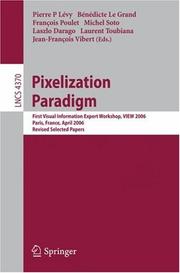
ISBN: 9783540710264 3540710264 9786610902200 1280902205 3540710272 Year: 2007 Publisher: Berlin, Heidelberg : Springer-Verlag,
Abstract | Keywords | Export | Availability | Bookmark
 Loading...
Loading...Choose an application
- Reference Manager
- EndNote
- RefWorks (Direct export to RefWorks)
The pixelization paradigm states as a postulate that pixelization methods are rich and are worth exploring as far as possible. In fact, we think that the strength of these methods lies in their simplicity, in their high-density way of information representation property and in their compatibility with neurocognitive processes. • Simplicity, because pixelization belongs to two-dimensional information visualization methods and its main idea is identifying a “pixel” with an informational entity in order to translate a set of informational entities into an image. • High-density way of information representation property, firstly because pixelization representation contains a third dimension—each pixel’s color—and secondly because pixelization is a “compact” (two-dimensional) way of representing information compared with linear one-dimensional representations (Ganascia, p.255) . • Compatibility with neurocognitive processes, firstly because we are thr- dimensional beings and thus we are intrinsically better at grasping one- or two-dimensional data, and secondly because the cerebral cortex is typically a bi-dimensional structure where metaphorically the neurons can be assimilated to “pixels,” whose activity plays the role of color (Lévy, p.3). The pixelization paradigm may be studied along two related directions: pixelization and its implementation and pixelization and cognition. The first direction—pixelization and its implementation—may be divided into two parts: pixelization theory and pixelization application.
Information visualization --- Computer vision --- Image processing --- Cognitive neuroscience --- Visualisation de l'information --- Vision par ordinateur --- Traitement d'images --- Neurosciences cognitives --- Congresses. --- Digital techniques --- Congrès --- Techniques numériques --- Computer Science --- Electrical Engineering --- Applied Physics --- Electrical & Computer Engineering --- Engineering & Applied Sciences --- Computer graphics --- Optical data processing --- Computer science. --- Algorithms. --- Artificial intelligence. --- Computer graphics. --- Image processing. --- Pattern recognition. --- Bioinformatics. --- Computer Science. --- Image Processing and Computer Vision. --- Pattern Recognition. --- Artificial Intelligence (incl. Robotics). --- Computer Graphics. --- Algorithm Analysis and Problem Complexity. --- Computational Biology/Bioinformatics. --- Bio-informatics --- Biological informatics --- Biology --- Information science --- Computational biology --- Systems biology --- Design perception --- Pattern recognition --- Form perception --- Perception --- Figure-ground perception --- Pictorial data processing --- Picture processing --- Processing, Image --- Imaging systems --- Automatic drafting --- Graphic data processing --- Graphics, Computer --- Computer art --- Graphic arts --- Electronic data processing --- Engineering graphics --- AI (Artificial intelligence) --- Artificial thinking --- Electronic brains --- Intellectronics --- Intelligence, Artificial --- Intelligent machines --- Machine intelligence --- Thinking, Artificial --- Bionics --- Cognitive science --- Digital computer simulation --- Logic machines --- Machine theory --- Self-organizing systems --- Simulation methods --- Fifth generation computers --- Neural computers --- Algorism --- Algebra --- Arithmetic --- Informatics --- Science --- Data processing --- Foundations --- Computer vision. --- Optical pattern recognition. --- Computer software. --- Artificial Intelligence. --- Software, Computer --- Computer systems --- Pattern perception --- Perceptrons --- Visual discrimination --- Machine vision --- Vision, Computer --- Artificial intelligence --- Pattern recognition systems --- Optical data processing. --- Optical computing --- Visual data processing --- Integrated optics --- Photonics --- Computers --- Optical equipment
| Listing 1 - 10 of 18 | << page >> |
Sort by
|

 Search
Search Feedback
Feedback About UniCat
About UniCat  Help
Help News
News